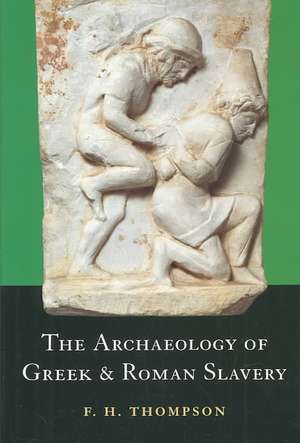The Archaeology of Greek and Roman Slavery
Autor F.H. Thompsonen Limba Engleză Hardback – 26 feb 2003
Preț: 954.45 lei
Preț vechi: 1219.66 lei
-22% Nou
Puncte Express: 1432
Preț estimativ în valută:
182.66€ • 189.99$ • 150.79£
182.66€ • 189.99$ • 150.79£
Carte tipărită la comandă
Livrare economică 14-28 aprilie
Preluare comenzi: 021 569.72.76
Specificații
ISBN-13: 9780715631959
ISBN-10: 0715631950
Pagini: 320
Dimensiuni: 160 x 240 x 27 mm
Greutate: 0.82 kg
Ediția:New.
Editura: Bloomsbury Publishing
Colecția Bristol Classical Press
Locul publicării:London, United Kingdom
ISBN-10: 0715631950
Pagini: 320
Dimensiuni: 160 x 240 x 27 mm
Greutate: 0.82 kg
Ediția:New.
Editura: Bloomsbury Publishing
Colecția Bristol Classical Press
Locul publicării:London, United Kingdom
Caracteristici
Covers topics as diverse as the source of slaves, the nature of the slave trade, and the use of slave-labour in agriculture, mines and quarries, corn and weaving mills, and water-lifting
Notă biografică
F.H. Thompson's interest in slavery was first inspired by his excavation of the Iron Age hill-fort at Bigberry near Canterbury in 1978-80. Later he participated in international expeditions to the slave-worked Roman quarries in Egypt's eastern desert. A study tour in search of slavery evidence took him all over Europe and the Mediterranean and ultimately led him to write this book. Ralph Jackson, who has written the Epilogue, is Curator of the Romano-British collections at the British Museum, UK.
Cuprins
List of Illustrations and Sources Foreword Kenneth S. Painter Preface1. Sources of Slaves and the Trade in Slaves2. Slaves in Greek Agriculture3. Slaves in Roman Agriculture: the Republic6. Slaves in Corn- and Weaving Mills and their Use in Lifting Devices7. Means of Restraint8. Flight and RevoltEpilogue Ralph Jackson Notes Abbreviations and Bibliography Index
Descriere
Slavery is a word heavy with emotional and political overtones - to be owned by another person and treated as a commodity is the ultimate injustice. This book covers topics as diverse as the source of slaves, the nature of the slave trade, and the use of slave-labour in agriculture, mines and quarries, corn and weaving mills, and water-lifting.
